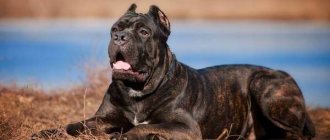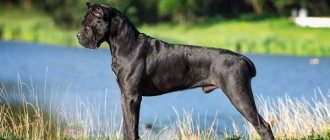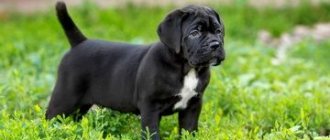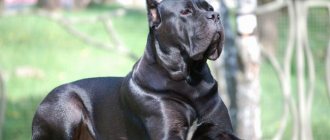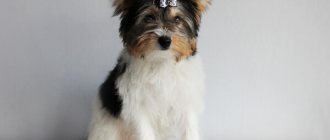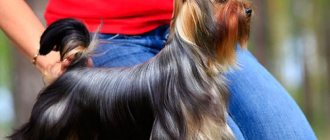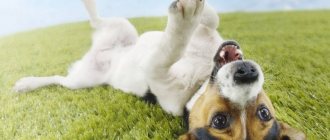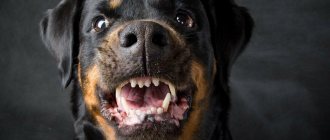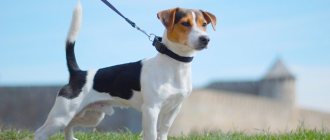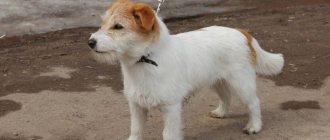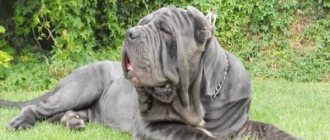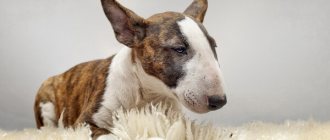When considering the Cane Corso, the description of the breed and the history of origin have a lot of interesting facts.
This dog is rightly considered the pride of Italian dog breeders.
After many years of “disgrace”, she gained wide popularity, which is facilitated by her special affection for her owners, good disposition and ability to perform official duties.
Given the huge demand, puppies have sharply increased in price, and therefore the choice must be made carefully and carefully, with knowledge of the characteristics of the breed.
Historical reference
The history of the appearance of the Cane Corso breed is associated with Ancient Rome.
Its ancestors are considered to be Molossian dogs, descended from the fighting dogs of Persia and Carthage, the mastiff-based breeds of Macedonia.
Ancient dog breeders specially bred this breed for guard and combat service, and therefore special attention was paid to its large size, devotion and lack of fear..
In addition to military specialization and gladiator fights, dogs took a worthy part in hunting large animals (even lions).
Along with the decline of ancient Roman civilization, Cane Corso also fell into disgrace.
The new nobility considered her insufficiently aristocratic and rustic. As a result, the dog ended up in the provinces and rural settlements, where they did not care about the purity of the breed. Previously, a single breed, due to various arbitrary mixings, was divided into several subspecies, losing many of its characteristic features.
Interest in the Cane Corso was restored by the Italian researcher and passionate dog lover Breber..
Only in the early 90s of the last century was he able to interest professional dog handlers and prove the right to exist of this breed as an independent species.
In November 1996, this status was officially approved. In 2003, the breed standard came into force.
The undeserved oblivion ended, and the Cane Corso became the pet of politicians, businessmen, and artists..
History of the origin of the species
The Cane Corso is an ancient breed that originates from the Molosser family, the ancient Roman gladiator dogs. The remains of similar animals were found in southern Italy and date back to BC.
In 1238, the coat of arms of the aristocratic family of De Corsi depicted a dog with similar features to the Cane Corso. This image was considered a symbol of masculinity, power, and courage. Although this breed was considered a domestic breed, unsuitable for secular society, its maintenance was honorable. Selection work was carried out randomly, so even in one village there could be individuals of different appearance and character.
The Cane Corso was often described by Italian poets and writers in their works (15-16 centuries). Teofilo Folengo tells of a bear and lion hunt during which Corso was wounded and killed. And during the Renaissance, these dogs were depicted by artists, admiring their muscles and structure. In addition, there are many proverbs associated with this breed.
As for the name, no one knows for sure why pets have this particular name. It is believed that the breed was formed on the island of Corsica, Conrad Gessner wrote about this in his work on “quadrupeds”.
Another version is completely unrelated to the island and the dogs’ habitat. From Latin, Corso is a watchman or guard, and Cane is a dog. From Greek, Corso means property surrounded by a fence . So it turns out, a dog protecting fenced property.
These pets served in all spheres of the peasants' working activities: they herded cattle, drove bulls, hunted, looked after children, and were indispensable in agricultural life. That is why, after the Second World War, during the active phase of industrialization, the number of dogs began to decline.
But Italian enthusiasts, led by Breber, decided to restore the breed line, selecting the most purebred individuals, and received the first standard - the dog Bazira . In 1984, Antonio Morsiani wrote the first breed standard. Cane Corso were recognized recently - in 1994.
Character traits
The breeder described the character of the Cane Corso dog quite clearly:
Expert opinion
Kozhevin Semyon Kirillovich
Expert dog handler.
“The Cane Corso can be safely called a very intelligent and smart dog, combining natural power and amazing nobility. She has a balanced temperament, without unjustified aggression. This dog will never offend anyone without a good reason. At the same time, she is able to stop any intruder who invades her domain, be it an animal or a person. There is no arrogance or ostentatious aristocracy in her, but a living soul is visible.”
The character traits of the Cane Corso have evolved over the centuries taking into account its main purpose - the protection and protection of a person and his possessions..
It can be considered a classic example of a guard dog. She embodies sedateness and poise, calmness and complaisance with full confidence in her abilities and enormous internal energy.
The Cane Corso is always ready to repel any threat to the owner and family members, even risking his own life.
She has an important ability - a clear division of everyone into friends and strangers (both people and animals).
NOTE!
The dog always vigilantly controls the situation, and at the first threatening movements of a stranger, it shows its readiness.
It is impossible to bribe her or distract her attention with any treats.
She always remembers her responsibilities. In case of a direct threat, it can act without the owner’s command. At the same time, her intelligence allows her to distinguish between real and imaginary threats, true danger and games.
A dog's devotion to its owner has no limits . Since puppyhood, she has been selflessly devoted to him. Ready to follow any commands and always be with him.
It is very difficult for him to survive long separations, and he may not survive betrayal at all. It takes a very long time to get used to the new owner and with great care.
Cane Corso has a special attitude towards children . A very developed parental instinct forces her to protect everyone who is smaller and clearly weaker than her. She is a faithful friend for the owner's children.
The dog also takes strangers under its wing. She lets the kids do whatever they want with her. As a last resort, she will simply quietly move away and hide.
A Cane Corso will never hurt a child . The dog is aware of its growth and strength, and therefore is very careful with small children. Children's crying is a real punishment for her.
The attitude towards other animals depends on whether they are our own or strangers. The Cane Corso gets along well with other pets in his own home, recognizing them as his own.
She is able to be friends with cats, parrots, turtles, small breed dogs and other animals. There are no problems at all if she met them as a puppy.
The attitude towards other people's dogs and animals is complex . The Cane Corso does not attack first, but if any aggression is shown by a “stranger,” it is capable of serious action.
In general, Cane Corso dogs are versatile animals with developed intelligence, quite agile, good-natured with a persistent character. They happily follow commands.
They love fun games with children and adults, but are unobtrusive . A dog needs emotional contact with its owner and other family members. They love company, but only speak on command.
Is this breed suitable for keeping in an apartment? Of course, any large dog needs a decent area, and the ideal condition is its own yard or plot.
However, the Cane Corso feels great in the apartment . If you give it its own small corner, then it will not cause inconvenience to the residents, despite its size.
Puppy care
Before you go after your pet, you need to determine where its place will be. You should also take care of purchasing all the necessary accessories.
After a Cane Corso puppy arrives in your home, it is important to provide him with the necessary conditions for normal development. You should be especially responsible when choosing high-quality food that contains all the necessary microelements and vitamins.
An equally important point is physical activity and walks. In childhood, Italian Mastiffs are very playful and active - but with age they become calm, measured and can lie down most of the time.
Suitable toys are something Cane Corso puppies definitely cannot do without. The duration of walks should be increased gradually so that children’s legs, which are vulnerable to diseases, get used to the load.
Care and maintenance
The Italian Mastiff is not whimsical. It can be kept in a city apartment, since an adult dog moves a little indoors. Therefore, despite its large size, a small angle is enough for it. But still, the Cane Corso feels more comfortable in a country house, where there is an opportunity to spend more time in the fresh air. At the same time, keeping an adult dog in a cold enclosure is only permissible in the warm season due to the weak undercoat. It is generally recommended to house Italian Mastiff puppies only in a house.
Accessories your dog needs include:
- Sun lounger. It should always be located in one place, where no one will disturb the Cane Corso.
- Bowls for food and water.
- Brush and massage mitt for combing.
- Toys - they should be large in size so that the pet does not accidentally swallow them.
- Leash, muzzle and collar. Since the Cane Corso is a large dog, it can only be walked on a leash. A muzzle must be worn while in public places.
You will also need soft cloths and cotton pads, a nail clipper, and a special shampoo.
Hygiene procedures
Caring for the body of Cane Corso dogs does not take much time. Typically it involves the following activities:
- Combing about once a week. It is especially important to do this during periods of shedding. Short hairs can be easily removed with a brush or massage mitt. Additionally, this procedure will improve blood circulation.
- You should check your dog's ears regularly. They must be clean and dry, odorless. In case of light contamination, it is enough to wipe them with a soft cloth or cotton pad. If sulfur or purulent discharge appears, you should contact a veterinarian. Since the Cane Corso has floppy ears, a procedure such as airing can also be useful. To do this, just take your ear by the tip and wave it like a wing.
- To maintain healthy teeth, it is beneficial for your dog to brush them. You can also give your Italian Mastiff special toys. Since these dogs have strong jaws, they love to chew on hard objects. You need to make sure that no stone or anything similar gets into the Cane Corso's mouth.
- It is advisable to wipe your eyes with chamomile decoction - this will prevent them from souring.
- After walks, you need to inspect your dog's paws. Cracks and scratches should be treated promptly with an antiseptic. It is also useful to regularly rub vegetable oil into the pads.
- Cane Corsos do not need frequent bathing, especially since their coat is short and stiff. This should only be done in case of heavy contamination once or twice a year. Dry shampoos are suitable for this purpose - they are less harmful to the coat of the Italian Mastiff. It is enough to wipe your paws after a walk.
One of the disadvantages of the Cane Corso is excessive drooling, especially after drinking and actively shaking its head. Therefore, you should always have a towel on hand, especially since, according to the owners of this dog, saliva is not easy to remove from wallpaper and clothing.
Feeding
Cane Corso is suitable for both industrial and natural food. The main thing is that protein predominates in it, since this dog is large and requires physical activity.
Industrial feed
The advantage of the finished product is that you do not need to waste time on cooking. But for Cane Corso you should choose exclusively premium food. Moreover, it is desirable that it be developed specifically for this breed. This will not be cheap, since an adult dog requires about 500–600 grams of dry food per day.
Natural feeding
This feeding method also has its pros and cons. The basis of the diet should be lean boiled and raw meat. Low-fat fermented milk products, cereals (except millet and pearl barley), vegetables, and fruits are added to it. All this is not cheap, and you will have to spend time preparing food. The advantage is that the dog will be guaranteed to receive high-quality nutrition. Although you will also need vitamin and mineral supplements, these will be selected by your veterinarian.
New vegetables and fruits should be introduced into the Cane Corso's diet gradually. If the dog likes the product and does not cause allergies, it can become part of the diet. Smoked foods, fatty and fried foods, sweets, and citrus fruits are contraindicated.
Walking and exercise
The Cane Corso dog needs long daily walks. The best option is 2–2.5 hours in the morning and evening. Physical activity is required: it should be outdoor games or running. Otherwise, the pet will try to throw out the accumulated energy at home. If the walks are regular and active, the Cane Corso will rest indoors.
Training and education
Italian Mastiffs are very intelligent dogs and therefore easy to train. Sometimes you can even hear the idea that there is no need to train a Cane Corso at all. They will learn everything themselves. This is wrong. Like any animal, the Italian Mastiff must understand commands and clearly know that it is required.
A representative of this breed really learns simple commands with ease. But if you plan to participate in competitions in the future, you cannot do without the services of a professional. After all, the Cane Corso is a guard dog, and special requirements are placed on it.
By the way, the Italian mastiff will guard the house even without special training - it’s in his blood. Therefore, you definitely don’t have to worry about property with such a pet.
Puberty and mating
Cane Corso females reach sexual maturity only at the age of one and a half years. The first mating is recommended when both partners are two years old. By this time, the body of individuals of both sexes will be fully formed and strengthened, which will allow them to produce healthy offspring.
Mating is carried out on the dog’s territory in the presence of both owners - this way the dogs will feel calmer. The optimal time for the meeting is 10 days after the start of estrus. Parents need to be selected specifically: with similar color and build. In this case, the chances of getting offspring that will meet the standards increase significantly.
Puppies - there are usually 3-5 of them - are born after 2 months. They are blind and helpless, and therefore it is necessary to provide a place for the mother where she can first lick the cubs and then provide proper care to the offspring. Childbirth in a Cane Corso usually occurs without complications, but it is still advisable to invite a veterinarian.
Advantages and disadvantages
Among the positive qualities of the Cane Corso, the following characteristics stand out::
- attractive, stately appearance, prestige;
- watchdog abilities, selflessness in protecting the entire family and property;
- absolute devotion to the owner;
- love of children and ability to get along with other pets;
- ease of hair care;
- tendency to train.
When choosing this breed, you must also take into account the presence of some negative aspects.:
- significant size and strength require proper training;
- a tendency to lead, requiring certain strong-willed qualities and patience from the owner;
- need for long walks (at least 2 hours a day);
- a sufficiently large volume of the daily diet;
- drooling;
- tendency to articular dysplasia;
- high cost of puppies.
Despite the presence of disadvantages, the positive qualities of the breed outweigh, and the Cane Corso has gained wide popularity.
She began to be considered a fairly prestigious and fashionable dog.
Cane Corso breed: where to buy
Nowadays, purchasing a purebred puppy of this breed is very problematic. In addition, choosing a puppy is a problem that can only be handled by a professional. Under no circumstances should you rely on your basic knowledge or simply on the recommendations of breeders.
It is very good if kennels that practice breeding dogs of a famous breed use imported producers related to the ancestors of real Cane Corsos. This will be proof that they sell dogs with typical behavior, high performance, strong bones and graceful movements. Parents of puppies must pass all tests and be verified by producers who are not prone to dysplasia.
What to pay attention to
When choosing a Cane Corso puppy, you should pay special attention to such factors as:
- The parents of the puppy have all the documents indicating that they have passed all tests for the presence of elbow and hip dysplasia, with an official conclusion from an RKF specialist.
- The parents have all tests related to the absence of mental defects, which must be certified in a separate document.
- A parent pair participating in breeding work must have a “very good” rating obtained at a breeding show.
As a rule, babies from multiple litters are larger in size, and they are stronger and more well-fed. Despite this, puppies must be absolutely healthy, active and playful, have an excellent appetite, show curiosity and not be cowardly. Nowadays, it is more common to sell animals that solely in appearance resemble breed standards.
These pets may develop various negative behavioral problems over time. This could be either a defect in the work of the breeders, or problems with raising the animal, which is more likely, since not all owners bother themselves with the problems of raising and socializing the animal.
All puppies offered must have all vaccinations and ears and tail docked. Babies can easily be determined whether they correspond to the breed type by their good anatomical structure, as well as by their clean and calm look. Such individuals are practically socialized and have a stable and strong psyche. All that remains is to properly raise the animal in the family, in a calm environment. Accompanying documents must indicate that the puppies have all vaccinations. The owner must have documents such as birth certificates, veterinary passports and a standard purchase and sale document in his hands.
Cost of Cane Corso puppies
It is quite natural that puppies whose pedigree includes producers of the most famous world-famous kennels, such as “Della Porta Dipinta”, “Del Rosso Malpelo”, “Cane Per La Vista” and “Best Griffs Off Destiem”, are the most expensive. The most expensive puppies, and therefore the most promising, quite often become titled, both abroad and in our country.
As a rule, the cost of a purebred puppy starts from 1 thousand dollars and no lower. At the same time, individuals with rare coat colors are much more expensive.
Characteristics of the breed
The breed standard normalizes the basic parameters that the animal must meet.
The Cane Corso belongs to the category of large dogs with powerful, well-developed muscles..
The proportions are characterized by a slightly elongated shape - the length of the body is greater than the height at the withers.
Such characteristics are standardized:
- The weight of a Cane Corso should be between 44-49 kg for a male and 39-45 kg for a female.
- Dimensions: height at withers for males – 63-67 cm, for females – 59-63 cm.
- Color variants of the breed. Cane Corso can be black, gray and red in different shades or brindle. There may be light spots on the paws and chest area. Red and brindle individuals have a dark-colored mask on their heads that extends over their eyes.
- The coat, regardless of color, is short and shiny, with no undercoat.
- Life expectancy with proper care is 10-12 years.
Adult dogs have a characteristic appearance. They are distinguished by a massive, slightly elongated head with a wide convex forehead. The body looks strong with a well-developed, wide chest area.
Ears and tail are most often cropped at an early age (the photo shows a Cane Corso with cropped ears).
Appearance standards and special breed traits
The Cane Corso combines beauty and power at the same time. According to the standard, representatives are allowed who:
- Male weight – 45-50 kg, female – 40-45 kg.
- The height of a male is 64-68 cm at the withers, the height of a female is 60-64 cm (deviations of 2 cm are allowed).
- The coat is smooth, short, uniform throughout the dog’s body. If there is long hair and a thick undercoat, this indicates that the animal is not a purebred representative of the Cane Corso breed.
- The color may be different, this is not considered a violation of the standard. Most often blue with admixtures of brown, red, black, spotted.
- The head is wider than long, without folds. The muzzle is shorter than the skull, square in shape, strong and flat.
- The Cane Corso has 42 teeth. The jaws are strong and curved. The lower jaw protrudes slightly forward.
- The eyes are oval and widely spaced. Eye color depends on the color of the dog.
- The ears are often cropped, giving them a triangular shape. They are naturally large, close to the cheek, smooth with shiny fur.
- The nose is black with wide nostrils.
- The neck is powerful and strong, in proportion to the body, of medium volume.
- The chest is powerful and wide.
- The back is straight with pronounced muscularity.
- The limbs are long, powerful and graceful.
- The tail is long, set high, reaching the length of the hock joints. Usually the tail is docked in newborn age.
Vices include:
- convergence of the longitudinal axes of the muzzle and skull;
- parallel arrangement of longitudinal axes;
- growth is below or above acceptable;
- bite shape – scissor;
- tail curled into a ring, tail standing upright;
- excessive aggressiveness of the dog, squint, eyesore, problems with the testes (testicles) - disqualification.
Important! A Cane Corso, brindle or red in color, must have a mask on the face, black or gray, and it should not go beyond the eye line.
Nuances of maintenance and care
The Italian Mastiff is an unpretentious dog, but certain rules for keeping and caring for them must be followed.:
- Dogs do not tolerate cold well. When kept in the yard, they need an insulated booth. Puppies should be kept in a warm room.
- The dog's physical activity is quite high. Walks should be long (at least 2 hours a day) with active games and running exercises. Playing together with other large dogs is desirable.
- Wool does not require special care. It should be combed periodically (at least once every 7-8 days) with a brush with natural, hard bristles. If necessary, flea and tick treatment should be carried out promptly.
- Constant ear hygiene is required. It is necessary to carefully check the ears and clean them.
- It is recommended to use special preventative chewing bones to clean your teeth.
- As the nails grow, they are trimmed.
If your dog gets dirty, you should clean the coat immediately after a walk. Bathing is done as soon as it gets dirty, but at least 2-3 times a year.
CAREFULLY!
Bathing too often is not advisable, because... wool may lose its protective properties. When bathing, special shampoos are used.
History of the breed
To find the beginning of the history of the Cane Corso breed, you need to “look” into the distant past. Representatives of the oldest group of Molossians are the direct ancestors of modern Corso. Their ancient Roman ancestors took part in competitions as gladiator dogs. Not only their powerful jaws and muscles, but also fearlessness helped corsas fight against opponents superior in size and strength, and win battles.
When the Roman Empire collapsed, these fighting dogs lost their popularity. At the beginning of the Middle Ages, the history of the Italian breed again gained momentum. Cane Corsos spread throughout Europe. Their images are preserved on canvases and engravings of that period. Artists could not ignore this fearless dog, which was used to hunt wild animals. The powerful dogs did not retreat before either the bear or the wild boar. The Italians of that time, and contemporaries too, say: “Brave, like Corso.”
Over time, the hunting skills of the Roman Molossians faded into the background and became unclaimed. Now the duties of the Cane Corso included the protection of livestock and farms. Dogs were used to transport large herds. In a word, dogs of this breed could be found in rural areas; they were very rare on city streets.
This lasted until the start of the war with the Nazis. Over the years of battles with the German invaders, the Cane Corso population decreased significantly. At the end of the war, the breed was on the verge of extinction. During this time, Italian dogs were rarely seen even on farmland. Experienced breeders managed to restore the breed and increase the number of its representatives, who noticed in time that the Cane Corso was facing extinction. The revival of the Roman Molossians began with a few surviving individuals of purebred blood. Now representatives of the Italian breed can be found both in the city and in the countryside. These dogs are no longer in danger of extinction; their popularity is growing.
Nutritional Features
Any large dog needs a sufficient supply of proteins, and their main supplier is meat. Therefore, the core of nutrition consists of meat and offal.
From puppyhood, she should be accustomed to dairy products, cereal-type porridges, vegetable and fruit additives . It is useful to give large bones. Raw meat can be used, but you should remember to prevent worms.
You should not give your dog fish with bones, especially raw fish. We must remember that raw river fish contains numerous parasites that can cause various diseases.
It is not recommended to give your dog smoke.
You should not get carried away with muffins, sweets and food high in carbohydrates.
You can feed your pet dry food, but it is better to choose premium food . Vitamins and minerals must be added to natural food, and their composition should be consulted with specialists.
Food must be fresh. Abrupt transitions from natural to dry food, and vice versa, are undesirable. They have too significant an effect on the dog’s gastrointestinal tract.
Read more about Cane Corso nutrition here.
Keeping a Cane Corso at home
This popular Italian breed does not require special housing conditions, and it will feel great both in a city apartment and on the street, in a specially equipped cage. Despite the ease of care, you still have to adhere to a number of recommendations for care and hygiene. It is very important to provide the animal with nutritious food.
Care and hygiene
Despite the fact that the Cane Corso breed is short-haired, it is still necessary to take care of the coat. The dog needs regular massage, as well as combing out dead hair. This will preserve the dog’s natural shine and beauty of its coat. To clean the fur, you can use a special medium-hard brush. It is necessary to comb the fur in the direction of its growth.
Ear hygiene comes down to standard actions to remove dirt or natural secretions, in the form of earwax. As a rule, the ears are cleaned with small cotton-gauze swabs. They are soaked in heated vegetable oil or in a special solution of chamomile with hydrogen peroxide.
It is important to know! Caring for a dog's oral cavity requires special measures, since tartar may form. To prevent this from happening, it is necessary to clean the dog’s mouth with pastes and brushes specially designed for this purpose.
If discharge in the form of purulent formations accumulates in the eyes of an animal, then this should not be classified as a pathology. These secretions should be carefully removed using a gauze cloth, which should preferably be moistened in a special solution of medicinal chamomile. If tartar does appear on the teeth, it can only be removed with the help of a professional.
What to feed your Cane Corso
Already from 3 weeks of age, the dog should be accustomed to a classic diet. Naturally, the puppy is fed according to a schedule, several times a day, dividing the diet into equal parts. Dishes for food and water should be at the same level as the chest on special stands. Natural food should include the following nutritional components:
- Lean meat.
- Sea fish.
- Boiled eggs.
- Low-fat milk.
Up to 2 and a half months of age, meat should be given, minced by scraping. For this age, lean beef, rabbit or chicken are suitable. Upon reaching 6 months of age, the animal’s diet should be expanded to include offal, as well as raw beef bones, including sea fish and dairy products. Buckwheat, oatmeal or rice porridge is prepared with milk. Foods such as cabbage, carrots and beets are high in vitamins and minerals. These include some berries and fruits.
Dry commercial food is also suitable for providing your pet with adequate nutrition. For an adult dog, the daily ration is calculated based on the requirement of about 20-40 grams per 1 kg of the animal’s body weight. It turns out about 1 kg of dry food per day.
Diseases and breed defects
This breed of dog may suffer from eversion or entropion of the eyelids, excessive tearing, and cherry eye. In this case, there is also bloating and epilepsy, problems with the normal functioning of the thyroid gland, as well as the manifestation of allergic reactions.
There may also be deviations in the parallelism of the muzzle and forehead, as well as anomalies in the shape of the muzzle, which may be expressed in an overly upturned or wedge-shaped shape. There is also partial depigmentation of the nose, a clear undershot or scissor bite, a hooked tail, against the background of deviations in growth standards.
The main disqualifying defects include a drooping muzzle, lack of pigmentation of the nose, hooked nose and underbite, lack of pigmentation of the eyelids, blue eyes, squint, including a stubby tail. The quality of the wool should not go beyond the requirements, so the wool should be short, not smooth and not have obvious fringes.
Education and training
The process of raising a Cane Corso should boil down to teaching the animal to follow the commands of its owner, regardless of the circumstances. Considering the fact that the breed is quite intelligent, harsh training methods should under no circumstances be used.
Important to remember! If you raise a dog of this breed correctly and professionally, then it will never bring problems to the owner, including his family members. In this case, emphasis should be placed on game-based learning methods, showing a certain persistence in executing the required commands. Excessive rudeness can lead to unmotivated stubbornness.
At the initial stages of training, the puppy must master basic commands, such as “Near”, “Sit”, “Lie down”, “No”, etc. At this stage, the puppy should get used to the leash and the basic requirements of discipline.
162. Training a Cane Corso puppy. First training
Pet health
The health of the Italian Mastiff largely depends on genetic background.
One of the most common problems is femoral dysplasia, which develops in the hip sector of the canine skeleton..
Even in a mild form, the disease leads to lameness, and in severe cases, loss of motor ability is possible.
The pathology is very difficult to control and treat. The most effective way is to prevent the appearance of new offspring with this problem.
Dog owners conduct x-rays of the joint before the first mating . When it is detected, measures are taken to limit the birth rate.
Diseases and life expectancy
Life expectancy largely depends on maintaining good health. On average, Cane Corsos live 13-14 years. The most common are diseases of the hip and elbow joints. The main reason for this is the heavy weight, which exerts serious pressure.
Cane Corsos are susceptible to injuries to joints and bones, leading to serious consequences, including death. Running and other active training should be carried out at an acceptable pace; if the owner cannot monitor the quality of the training himself, it is better to contact a dog handler. Diseases of the eyes, thyroid gland, nervous system, and allergic reactions are less common. It is recommended to be examined by a veterinarian annually to detect them in a timely manner.
Education and training
Raising a dog should begin from a very early puppyhood.
It is important to help the puppy learn about the world around him and perceive it correctly in different situations..
Already at this age, training goes in two directions - discipline and obedience, as well as professional, watchdog qualities. It is best to carry out education immediately with the involvement of a specialist.
A dog's normal character is formed in several ways . First of all, a good genetic code is ensured as a result of selection. One of the effective methods is imprinting.
It involves keeping the puppy with a trained mother for a long time. Through her example, he receives the necessary education. Another way is to socialize the dog.
Starting from 3-4 months of age, the puppy should have active contact with people and other animals.
How to choose?
The choice of a Cane Corso puppy must be carried out with knowledge of the characteristics of the breed.
First, you need to decide for yourself the question of the purpose of the animal - whether it will be a guard and protector or just a kind, pet, to please only household members or to be shown at exhibitions.
Accordingly, the choice of dog is made taking into account the requirements.
You should purchase a puppy at least 8 weeks old, when he is already capable of full independent nutrition . His weight at this age should be at least 7-8 kg.
It is important to find out all the ins and outs of the parents and whether they have genetic problems. It wouldn’t hurt to clarify the number of individuals in the litter. The optimal option is 5-7 puppies.
Next, the physical and external characteristics of the puppy are checked according to the breed standard.
Cane Corso dogs older than 3 months should be taken with great care . They have a very hard time getting used to their new owner. In this case, specialist consultation and special care and attention to the pet are necessary.
Interesting Facts
The Cane Corso dog breed has been popular among owners for a long time. The history of its origin dates back to the times of Ancient Rome, so there are many interesting facts about this breed:
- It is considered one of the most valuable dogs in historical terms. Thanks to archaeological excavations, it was possible to discover the unique remains of ancient dogs of Italian origin, which are similar to the current Cane Corso.
- There is a mention of Cane Corso by the Italian poet Teofilo Folengo (1491-1544). There the author describes a mortal fight between a dog, a bear and a lion. Also, thanks to its fearlessness, this breed is mentioned in many famous works.
- The history of the origin of the name of the Cane Corso breed has not yet been precisely established. There are theories, but none of them have been officially confirmed.
- This breed of dog is widely in demand in Europe, where it is used by influential people as bodyguards.
- The Cane Corso can often be seen as a security guard at an expensive store in Europe; this adds prestige to the boutique itself and its owner.
- Politicians, famous businessmen and other influential figures are often seen accompanied by this breed.
- A representative of the breed named Boris received recognition from the FCI (International Association of Cynological Federations).
- The phrase: “brave as a Corso” can often be heard in Italy.
How to name?
When choosing a nickname for his pet, the owner is free to show maximum imagination. You can remember the Italian roots of the Cane Corso and use something reminiscent of that country.
You can offer other ideas:
- For boys – Archie, Apollo, Albus, Arnie, Baron, Bucks, Wooddy, White, Thunder, Duke, Gore, Dexter, Jack, Dave, Georges, Zidane, Zeus, Crispus, Courage, Krief, Casper, Lyon, Lexus, Mike , Maurice, Nord, Nice, Norman, Oliver, Osman, Onyx, Parker, Prime, Rich, Rider, Ringo, Spartak, Stif, Snike, Sultan, Tyson, Teach, White, Walter, Frank, Hulk, Hallie, Caesar, Chief , Chip, Chase, Shah, Alvin, Ernie, Justin.
- For girls - Alma, Aisa, Angel, Barca, Beta, Bessie, Venus, Vicky, Gloria, Gizma, Dana, Diya, Zita, Zara, Ilsa, Irma, Cassie, Cleo, Keri, Lilu, Lucky, Molly, Maya, Nika , Nancy, Ollie, Piggy, Pixie, Roxy, Richie, Sally, Selina, Stacy, Tori, Terra, Ulli, Ulma, Fanny, Fiona, Flora, Chloe, Holdie, Tsara, Cessie, Chelsea, Sherry, Sheila, Elsa, Ellie , Yumi, Utah.
We must try to name the pet so that the nicknames do not repeat next to each other.
In addition, you should not use nicknames that are similar to the names of family members and teams.
Varieties
The purebred Italian Cane Corso is included in the international standard as a separate breed. However, there are mastiffs (large and powerful dog breeds whose ancestors fought in the arenas of Ancient Rome) that are similar in appearance to the Cane Corso. The main ones include:
- German boxer.
- German dog.
- Bullmastiff.
- English Mastiff.
These breeds are indeed similar to the Cane Corso and have family ties to the breed, but they differ in behavioral habits and many other characteristics.
